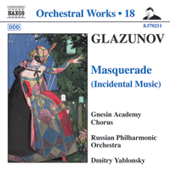Masquerade/Glazunov
July 31, 2009


Over my many years of listening to Russian classical music Alexander Glazunov has been one of the staples in my collection. Alexander was quite prolific with 110 numbered works and another 40 works without an opus number. He began composing at a rather early age (16) and he continued for 50+ years composing 8 symphonies, 7 string quartets, 5 concertos, 3 ballets, and numerous orchestral works. However, “Masquerade” slipped under my radar and this new Naxos release #8.570211 is my first experience with this music except for the “Valse-Fantaisie” section of the work, a highly addictive melody of the first order. This is something I’ve heard and enjoyed for many years.
The Lermontov play, written in 1836,was a criticism of the decadence of the St. Petersburg society and his critique of contemporary society was promptly banned for 30 years. Glazunov wrote the music in 1912-13 for Meyerhold’s production, which was performed in 1917. Even though there are 26 tracks for the 38+ minutes it is recorded in such a way that the transition from track to track flow isn’t noticeable at all. While this reviewer has never had the opportunity to see a production of the play I had no problem listening to the music as a separate stand-alone experience. It is filled with wonderful dances written in Mazurka, Quadrille, Galop, Polonaise, and Valse style, all melodic and quite easy on the ear. While the work definitely has the sound of Russia and Glazunov, it doesn’t have the heaviness in the orchestration, which is often associated with Russian classical material. One could easily download the five dance and waltz tracks to a MP3 device and have 16 minutes of easy to listen to material. Act 1V Scene 1 is certainly one that you would hear in a church and the Gnesin Academy Chorus without orchestra sings it in a very moving religious rendition. The chorus is also a welcome addition to the “Mazurka,” a lively dance with another catchy melody. You’ll also enjoy the melodies of the “Polonaise,” “Galop,” and the “Quadrille.”
Two Pieces, a work written early on (1886) is a fine example of the tranquil delicate side of Alexander. It features first a pastoral setting and then a bit oriental mystery and intrigue. Pas de caractere is a Hungarian dance filled with a gypsy passion. Intermezzo romantico, has a title that s peaks for itself.
While I cannot put Glazunov in a top category as a composer I certainly must rate him as being well above average for all of the recordings that I own. This recording is no exception. It is one that is filled with a variety of styles, orchestrations, and strong melodies. The Naxos affordable price is always a bonus. Recommended
Maintitles rating is ***1/2
Performed by: Russian Philharmonic Orchestra conducted by Dmitry Yablonsky and the Gnesin Academy Chorus
Naxos CD# is 8.570211
Track Listing:
Act I
1….Tableau 2 (0:47)
2….Pantomime 1 (0:32)
3….Mazurka…. (4:07)
4….Pantomime 3 (1:53)
5….Quadrille (1:11)
6….Pantomime 4 (1:09)
7….Scene 2 (0:50)
8….Pantomime 5 (0:23)
9….Scene 3 (1:06)
10. Pantomime 6 (0:59)
11. Scene 4 (0:47)
12. Pantomime 7 (0:13)
13. Entrance 7 (0:28)
14. Pantomime 8 (0:17)
15. Scene 6: Galop (2:24)
Act III
16. Tableau 8: Polonaise (3:04)
17. Tableau 3: Chiming Clock (0:59)
18. Tableau 6 (0:24)
19. Valse-Fantaisie (5:37)
20. Tableau 9 (1:02)
21. Entr’acte (1:45)
Act IV
22. Scene 1 (3:15)
23. Entrance 6 (0:27)
24. Pantomime 11 (0:22)
25. Chorus (0:37)
26. Moderato (2:56)
Two Pieces, Op. 14
27. No. 1: Idylle (8:38)
28. No. 2 Reverie orientale (7:15)
29. Pas de caractere, Op. 68 (2:22)
30. Romantic Intermezzo, Op. 69 (11:09)
Total Time is 66:57